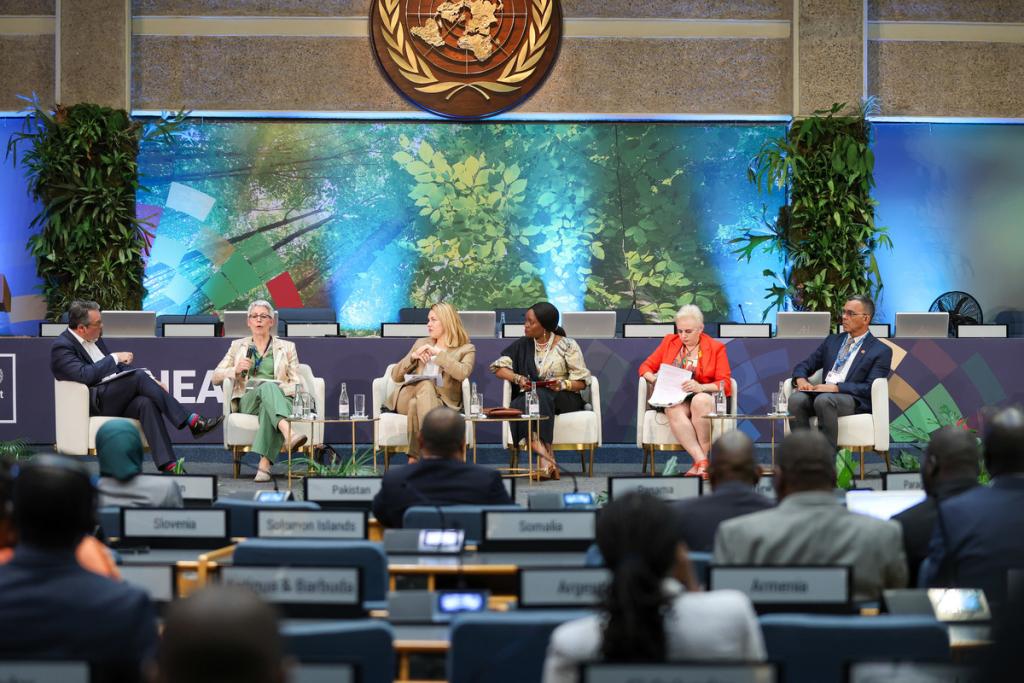What’s Next After UNEA-6: Why “synergies” is more than a buzzword for countries tackling the triple planetary crisis
In an era marked by escalating environmental challenges and geopolitical tension, the Sixth United Nations Environment Assembly (UNEA-6) called for more cooperation to tackle the triple planetary crisis.
The UN Environmental Assembly (UNEA) is the world’s highest decision-making body where the international agenda is set to tackle global environmental issues. Between February 26 and March 1, under the theme “effective, inclusive and sustainable multilateral actions to tackle climate change, biodiversity loss and pollution,” 190 countries negotiated over a dozen resolutions covering multiple aspects of the triple planetary crisis we are facing—climate change, nature and biodiversity loss, and pollution and waste.
Although many member states stressed the urgency of all three crises, negotiations were constrained by current geopolitical fragmentation. Several draft resolutions ended with no agreement. As IISD’s Earth Negotiations Bulletin (ENB) noted, “resolutions were weak from the beginning, and efforts to reach consensus watered them down even further, leading to outcomes described by many as underwhelming at best.”
However, a glimmer of hope among the adopted resolutions was UNEA Resolution 6/7, which focused on “promoting synergies, cooperation or collaboration for national implementation of multilateral environmental agreements and other relevant environmental instruments.” It “encourages” countries to enhance the synergistic implementation of different multilateral environmental agreements (MEAs)—including the Paris Agreement and the Kunming-Montreal Global Biodiversity Framework—at the national and subnational levels.
At the heart of this resolution lies a recognition of the interplay between climate action, biodiversity conservation, and sustainable development. The resolution encourages countries to enhance their knowledge and understanding of the potential co-benefits of synergies, cooperation, or collaboration and collect and share good practices to foster information exchange and international cooperation.
This commentary delves into the question of why synergies are essential in implementing the different MEAs and points to a couple of entry points on how countries could implement this resolution.
Creating Bridges, Not Silos: Why are synergies essential in implementing MEAs?
As countries grapple with the complex interplay and the far-reaching consequences of the triple planetary crisis—climate change, biodiversity loss, and pollution—the need to break down silos and adopt an integrated approach to confronting these challenges has never been more crucial.
Central to this understanding is the fact that these crises are deeply intertwined. They often share the same underlying drivers, and the compounded impacts of these crises increase the vulnerability of people and the ecosystems they depend on. The latest assessments by the Intergovernmental Panel on Climate Change and Intergovernmental Science-Policy Platform on Biodiversity and Ecosystem Services point out that climate change directly results in habitat and biodiversity loss. Persistent fossil fuel usage, combined with land-use change and desertification, continues to degrade ecosystems—undermining their capacity to absorb carbon dioxide—thus leading to further climate change and threatening ecosystem integrity and human health.

The solutions to the three crises are often interlinked as well. Targeted actions to mitigate climate change, such as the adoption of renewable energy or reforestation, often support biodiversity conservation and reduce air pollution. Meanwhile, efforts to protect ecosystems, like well designed and implemented nature-based solutions, can generate and protect new habitats, sequester carbon, bolster the resilience of ecosystems to climate impacts, and enhance protection against natural hazards — thereby contributing to the overall resilience of people and ecosystems to the changing climate.
Hence, MEAs share common themes and objectives and often link to one another through direct references. This creates a foundation for actively identifying synergies among efforts to implement these global agendas, increasing efficiency and effectiveness for improved outcomes.
While often used as a buzzword, synergy remains fundamental to coherent planning and implementation of national environmental strategies and actions. It means ensuring alignment and seeking linkages between the different plans and actions aimed at addressing these crises so that the result of their joint effort is greater than the sum of their individual effects.
When various environmental (and social) policies work together in a coordinated manner toward sustainable development, they can produce outcomes that are more effective, inclusive, and efficient than if they are planned and implemented independently.
However, the national planning and implementation of these solutions are often fragmented. These processes might be the responsibility of different ministries or departments, resulting in missed opportunities for linkage and synergy. For instance, climate change, forestry, agriculture, fisheries, and air pollution may fall under several ministries that don’t always talk to each other. Siloed approaches compartmentalize environmental challenges and policy approaches, likely causing inefficient allocation of already limited human and financial resources.
Fostering synergies, cooperation, or collaboration when implementing the various MEAs at the national level will not only help countries achieve their respective international commitments but will also enable smarter use of resources and improve the quality of planning. This can help overstretched ministries or departments identify potential cost savings around reporting, staffing, and co-benefits—minimizing trade-offs and achieving sustainable development more efficiently.
What’s Next: How can countries implement this resolution?
The resolution adopted at UNEA-6 calls on countries and relevant stakeholders to share good practices, tools, success stories, and lessons learned to increase the international community’s understanding of co-benefits of synergies, cooperation, or collaboration.
While coordinated policy responses to ensure synergies between MEA implementation at the national level are still scarce, practical examples and policy opportunities exist. However, these synergies do not happen automatically. It is a political choice by governments to take specific steps and actions to promote higher degrees of coordination and collaboration in addressing the triple crisis. Here are three practical entry points to get started on strengthening synergies:
- Ensure high-level political commitment and promote collective responsibility for implementing MEAs: Greater synergies begin with clear and publicly expressed—and substantiated—political commitment from the highest levels of office, which spells out a mandate for coordination and collaboration to achieve synergies. This can be expressed via the establishment of a high-level cross-ministerial working group in which all relevant ministries are required to contribute to the joint implementation of MEAs. Further, high-level goals need to be underpinned by a clear allocation of responsibilities for different ministries that spell out measures and sub-goals that contribute to the agreed collective goal.
- Map out and strengthen linkages between climate change, biodiversity, and sustainable development strategies to maximize impact, avoid duplication, and prevent policies from undermining each other: National policy integration is a prerequisite for tackling complex challenges. Synergies entail creating consistencies and linkages between relevant policies and plans. Policy mapping can be an efficient way to identify synergies and integrated actions for leveraging impacts and preventing policies from undermining each other, such as aligning national climate change plans with biodiversity strategies.
- Build capacity to strengthen cross-sectoral collaboration and synergistic outputs: The formation of inter-ministerial working groups and coordination mechanisms is crucial to supporting synergies and joint processes. Establishing a formal body for coordination does not necessarily guarantee inclusive and cohesive collaboration among ministries. Constraints to coherence often include hierarchical structures and cultural differences between spending and regulatory departments. Actors involved in these working groups must build a trustful and enabling work environment. So-called “ambassadors” or “champions” who bring the right people to the table are important for building mutual understanding and facilitating dialogue.
Moving Forward on the Synergies Agenda
Promoting and pursuing synergies has the potential to maximize the efficiency and effectiveness of MEAs while minimizing trade-offs. UNEA provided a good starting point to further the synergies discussion—and now it is up to member states to continue the conversation at the upcoming UN Biodiversity Conference in Cali, Colombia (COP 16) and the Baku UN Climate Change Conference (COP 29).
To implement this resolution, governments should actively share and exchange good practices and experiences of their current efforts to enhance synergies. This could be done through targeted information exchanges at international conferences or by leveraging member states’ reporting and submissions to the different conventions and international agreements, such as through highlighting progress on multiple crises in their Biennial Transparency Reports under the Paris Agreement or their updated National Biodiversity Strategy and Action Plans under the Convention on Biological Diversity.
You might also be interested in
UNFCCC Submissions Tracker
Tracking and sharing opportunities for stakeholders to give input to the UN climate change negotiations.
The State of Global Environmental Governance 2023
In global environmental talks in 2023, the focus across nearly all issue areas was funding implementation and reviewing performance.
What Is the UAE Framework for Global Climate Resilience, and How Can Countries Move It Forward?
With the introduction of the new framework for the Global Goal on Adaptation (GGA), COP 28 marked a milestone for adaptation. We unpack key outputs and set out how countries can move forward by strengthening their national monitoring, evaluation, and learning (MEL) systems.
CSDDD: EU's Due diligence law vote should drive supply chain sustainability efforts
The European Parliament has voted to adopt the Corporate Sustainability Due Diligence Directive, aiming to address the environmental and social impacts of the supply chains of Europe's large corporations.
